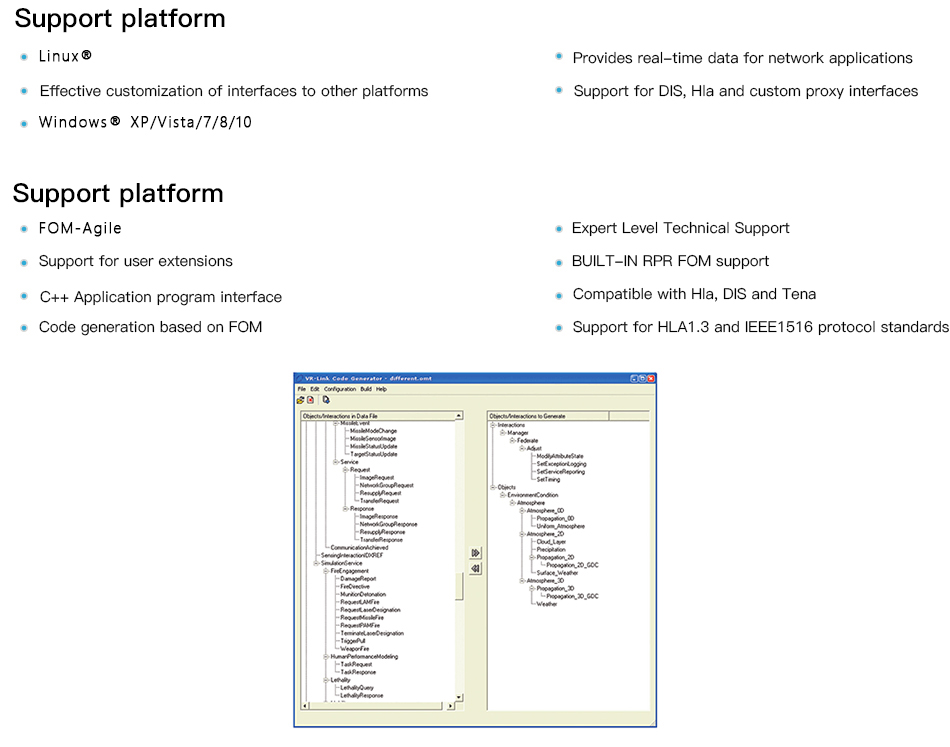Welcome to the official website of SEASTARS CORP.,LTD.
Simulation Internet Toolkit VR-Link
Simulation Internet Toolkit VR-Link
Using the VR-Link network toolkit, you can easily and quickly connect various simulators and virtual reality simulation applications based on the U.S. Department of Defense High-Level Architecture (HLA) or Distributed Interactive Simulation Protocol (DIS) through the network. VR-Link's powerful functions, easy-to-use programming interface, and powerful code generation tools reduce risks, costs and time required for maintaining existing simulation applications or developing new simulations. VR-Link simulation fully complies with the HLA protocol and is fully compatible with the original DIS project.
product description
Protocol independent API
VR-Link saves simulation development costs by providing a single-document application program interface that does not need to consider network details. When the user writes code using the VR-Link application program interface, the simulation application is automatically compatible with DIS, HLA 1.3, IEEE1516 and TENA. For example, most VR-Link applications that originally supported the HLA1.3 protocol only need to be recompiled once to support IEEE1516.
RTI underlying parameters and remote entity access
VR-Link uses protocol-independent APIs to set the status of local simulation entities and objects, and automatically send application information to the receiving end through HLARTI, DIS network or TENA middleware. VR-Link provides access to the current state of remote entities. It can also realize the functions of route smoothing, threshold setting, coordinate conversion, response to attribute requirements and filtering processing. VR-Link supports users to control the details of the underlying network transmission. Through the channels provided by the underlying API, users can directly access the RTI, each update and PDU content, and the specific details of the DIS connection parameters.

FOM flexibility
The FOM-Agile infrastructure of VR-Link allows users to create a simulation member that can switch between several different federations at one time by selecting the appropriate plug-and-play FOM table. VR-Link uses RPRFOM format FOM tables to provide interoperability of simulation applications, and provides tools and examples to help users develop new FOM tables for other federal object models. Once the FOM table of a particular federated object model is established, all applications built on the basis of VR-Link (including MÄK Stealth, MÄK PVD, MÄK Data Logger, MÄK Gateway, VR-Exchange and VR-Forces) can be used Interoperable application interaction.
FOM-based code generation tool
VR-Link supports most of the general concepts of distributed simulation through the provided API, and supports user-customized development of custom FOM elements, including the extension of RPR FOM classes, and the addition of different simulation concepts. VR-Link provides code generation The device completes the user-customized extension of the application. The VR-Link code generator reads the HLA FOM and automatically generates the VR-Link extension for the FOM. The files generated by the code generator include: C++ style source files and header files, Microsoft C++ solution files, classes generated by UNIX makefiles, classes used to publish and track new HLA objects, and complete the sending and receiving of customized interactions. The XML-based FOMs of the VR-Link code generator work on HLA1.3 OMT files and IEEE 1516.
Flexible and portable support
The object-oriented design of VR-Link and the characteristics of writing in C++ language provide users with flexibility. Users can rewrite the default functions, use the modified or new FOM table through the extension toolkit, or use the user-defined DIS PDU ; As a cross-platform toolkit, VR-Link includes sample source code and a lot of development guidance. In addition, MÄK provides users with strong technical support. Users can directly communicate with VR-Link's core development engineers. comminicate. Because MÄK is a member of the standards development organization, VR-Link will support the new network communication protocol.

Contact Us
14th Floor, Block A, China International Science & Technology Exhibition Center, 12 Yumin Road, Madian, Chaoyang District, Beijing



